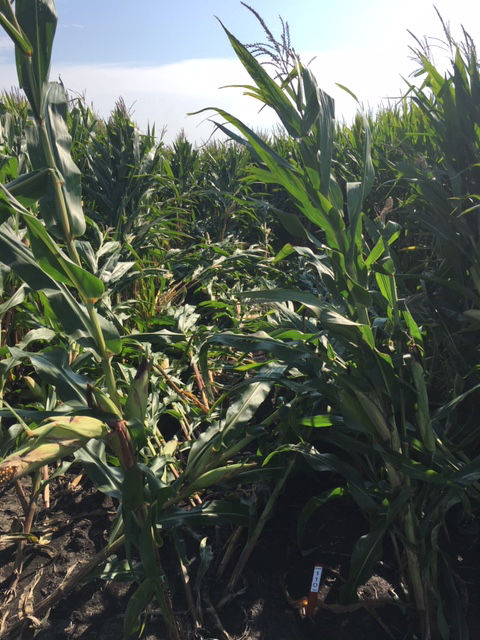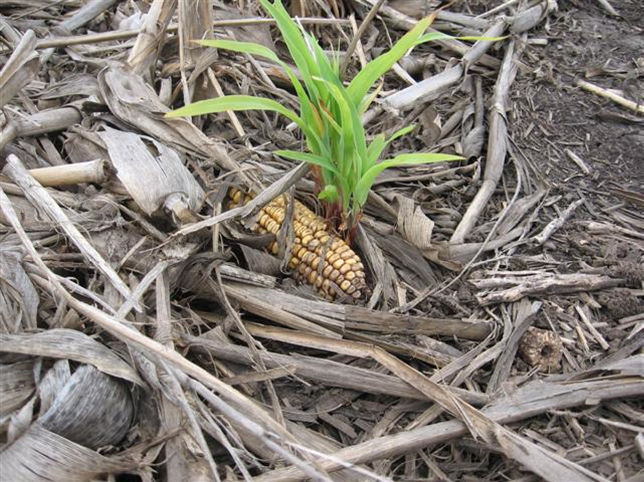5 MIN READ
Volunteer Corn Management in Corn
June 6, 2023
- Lodged corn resulting from high wind, disease, or physiological stalk rot can increase the likelihood of volunteer corn in the following crop.
- Volunteer corn is a “weed” in the following crop that can reduce yield potential, potentially be a source for disease inoculum, and can impact corn rootworm management.
- Managing the potential for volunteer corn should begin at harvest and continue the following spring.

Figure 1. Volunteer corn in corn. Image courtesy of Jenni Rees, University of Nebraska.
Impact
Down corn resulting in the inability to recover the grain during harvest can be a major source for volunteer corn (Figure 2). Research conducted at the University of Nebraska found that volunteer single corn population of 3,500 plants/acre resulted in a 2% yield reduction in corn. When the volunteer corn population was doubled, to 7,000 plants/acre it resulted in a 5% yield reduction.1 While clumps of volunteer corn (Figure 3) resulted in a greater yield loss as they were more competitive than individual plants. A density of 7,000 clumps of corn/acre resulted in a 14% yield loss, more than a 11% increase over similar density of individual plants.1

Figure 2. Lodged corn.

Figure 3. Volunteer corn from dropped ear.
Harvesting tips for down corn:1,2
- Evaluate the lodged field before adjusting combine or purchasing additional harvesting equipment. Detached ears are not likely to be harvested; therefore, adjustments or additional gathering equipment to pull these ears into the machine is unlikely.
- Harvest as soon as possible. If stalk rot was the cause for the downed corn, the stalks are likely to become increasingly weaker and ears may mold where they touch the ground.
- Follow the combine manufacturer’s manual for cylinder adjustments, speed, and clearance settings.
- Keep snouts as low as possible and consider removing ear savers as they may prevent ears from entering the header. Adjust the angle of the header to get gathering chains as low as possible.
- Set gathering chains so the lugs are opposite each other and close together. The deck plates over the snapping rolls should be slightly wider than the stalks so they hold the stalks but wide enough to keep the stalks from becoming wedged between the plates.
- Try harvesting against the angle of the lodged corn to help maximize lift into the header. After harvesting a small distance, evaluate gathering performance behind the combine and compare to an unharvested area. If loss is still considerable, adjust settings or consider harvesting a different direction.
- Corn reels or rotating cones may improve harvest efficiency.
- Harvest when dew is present to help minimize fluff.
- Avoid over-threshing.
- Set combine to blow out as much of the fines and foreign material as possible.
- Above all, be safe. Shut the combine down before attempting to remove plugged material from header and other moving parts.
Fall Management to Help Reduce the Potential for Volunteer Corn
Tillage
Early fall tillage can help initiate germination of lost grain prior to a winter freeze, reducing the amount of grain that may germinate in the spring. Where large amounts of grain have been lost to down corn, deep tillage with a moldboard plow can prevent the seed from germinating. Shallow tillage, such as field cultivation, can kill emerged volunteer corn; however, it can “plant” seeds that germinate in the spring. For growers utilizing no-till practices, ears and kernels will be exposed to winter weather and wild animal and bird feeding. By not incorporating seed into the soil, it is left on the soil surface where it is much less likely to result in successful germination and emergence.
Livestock
Where practical, allowing livestock to graze on non-tilled fields can help reduce the potential for volunteer corn and be beneficial with the return of nutrients through their waste. However, seeds can pass through the digestive system and remain viable. Grazing should be discontinued prior to spring thawing to decrease the potential for livestock caused compaction.
Spring Management for Volunteer Corn
Delayed planting may not be a viable option; however, delayed planting can allow for considerable amounts of volunteer corn to germinate. The germinated seed can be controlled through tillage or labeled burndown herbicides.
Herbicides for Volunteer Corn in Corn Acres
- Controlling volunteer corn in a current corn crop is more problematic because of the herbicide-resistance of the previous corn crop. If a glyphosate-resistant ONLY corn product was planted the previous year and a corn product with both glyphosate and glufosinate resistance is planted next, Liberty herbicide could be used to control the glyphosate-resistant volunteer corn – DO NOT APPLY LIBERTY® HERBICIDE (GLUPHOSINATE) IF THE CURRENT CORN CROP IS ONLY RESISTANT TO GLYPHOSATE.
Sources:
1 Rees, J. and Jhala, A. 2018. Impacts of Volunteer Corn on Crop Yields. University of Nebraska. https://cropwatch.unl.edu/2018/impacts-volunteer-corn-crop-yields
2 Hanna, M. 2011. Harvest tips for lodged corn. Integrated Crop Management. Iowa State University. https://crops.extension.iastate.edu/cropnews/2011/09/harvest-tips-lodged-corn.
3 Bergman, R. and Saeugling, A. 2020. Combine adjustments for harvesting lodged corn. Integrated Crop Management Blog. Iowa State University Extension and Outreach. https://crops.extension.iastate.edu/blog/aaron-saeugling-kristina-tebockhorst-mark-hanna-ryan-w-bergman-shawn-shouse/combine-adjustments
1223_155804